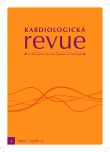Pulmonary embolism
Authors:
I. Hofírek
Authors‘ workplace:
I. interní kardioangiologická klinika FN u sv. Anny v Brně
Published in:
Kardiol Rev Int Med 2009, 11(4): 170-173
Category:
Sympozium
Overview
The paper reviews pulmonary embolism as part of thromboembolic disease that represents an important medical and social and economic problem. The paper reminds the readers of the main epidemiological and pathophysiological data relevant to thromboembolic pulmonary embolism. It summarizes the risk factors and clinical picture of the disease and opinions relevant to the use of diagnostic methods. The paper selects what is important according to literature and to clinical practice in particular. Apart from anamnesis and patient clinical status, echocardiography and CT angiography of the pulmonary vein are included. Laboratory examinations (for example D‑dimer and troponin determination) represent supportive prognostic measures. The paper highlights discrepancies in understanding of the term massive pulmonary embolism with respect to CT description and clinical status of the patient and some diagnostic and therapeutic difficulties in patients with chronic obstructive pulmonary disease and in pregnant women. It comments on the treatment modalities such as heparin therapy and thrombolysis, and the currently discussed approaches, including thrombectomy and endovascular techniques.
Keywords:
pulmonary embolism – massive pulmonary embolism – thrombolysis
Sources
1. Goldhaber SZ. Deep venous thrombosis and pulmonary embolism. In: Fauci AS, Braunwald E, Kasper DL et al (eds). Harrison’s Principles of internal medicine. 17th ed. New York: McGraw-Hill 2008 : 1651–1655.
2. Penka M. Plicní embolie. In: Dítě P et al (eds). Vnitřní lékařství. 2. vyd. Praha: Galén 2007 : 103–106.
3. Widimský J, Malý J et al. Akutní plicní embolie a žilní trombóza. Praha: Triton 2002 : 51.
4. Tapson VF. Acute pulmonary embolism. N Engl J Med 2008; 358 : 1037–1052.
5. Geerts WH, Bergqvist D, Pineo GF et al. Prevention of venous thromboembolism: American College of Chest Physicians Evidence-Based Clinical Practice Guidelines. 8th ed. Chest 2008; 133: S381–S453.
6. Silverstein MD, Heit JA, Mohr DN et al. Trends in the incidence of deep vein thrombosis and pulmonary embolism: a 25‑year population‑based study. Arch Intern Med 1998; 158 : 585–593.
7. Anderson FA jr, Wheeler HB, Goldberg RJ et al. A population‑based perspective of the hospital incidence and case-fatality rates of deep vein thrombosis and pulmonary embolism. The Worcester DVT Study. Arch Intern Med 1991; 151 : 933–938.
8. Major KM, Bulic S, Rowe VL et al. Internal Jugular, Subclavian, and Axillary Deep Venous Thrombosis and the Risk of Pulmonary Embolism. Vascular 2008; 16 : 73–79.
9. MacDougall DA, Feliu AL, Boccuzzi SJ et al. Economic burden of deep-vein thrombosis, pulmonary embolism, and post‑thrombotic syndrome. Am J Health Syst Pharm 2006; 63: S5–S15.
10. Riedel M. Choroby plicního oběhu. 1. vyd. Praha: Galén 2000 : 131–149.
11. James AH, Jamison MG, Brancazio LR et al. Venous thromboembolism during pregnancy and the postpartum period: incidence, risk factors, and mortality. Am J Obstet Gynecol 2006; 194 : 1311–1315.
12. MacKenzie JD, Nazario-Larrieu J, Cai T et al. Reduced‑dose CT: Effect on reader evaluation in detection of pulmonary embolism. Am J Roentgenol 2007; 189 : 1371–1379.
13. Anderson DR, Barnes DC. Computerized Tomographic Pulmonary Angiography Versus Ventilation Perfusion Lung Scanning for the Diagnosis of Pulmonary Embolism. Curr Opin Pulm Med 2009; 15 : 425–429.
14. Kucher N, Rossi E, De Rosa M et al. Massive pulmonary embolism. Circulation 2006; 113 : 577–582.
15. Corwin MT, Donohoo JH, Partridge R et al. Do Emergency Physicians Use Serum D‑dimer Effectively to Determine the Need for CT when Evaluating Patients for Pulmonary Embolism? Review of 5,344 Consecutive Patients. Am J Roentgenol 2009; 192 : 1319–1323.
16. Janata K, Holzer M, Laggner AN et al. Cardiac troponin T in the severity assessment of patients with pulmonary embolism: cohort study. BMJ 2003; 326 : 312–313.
17. Kline JA, Zeitouni R, Marchick MR et al. Comparison of 8 biomarkers for prediction of right ventricular hypokinesis 6 months after submassive pulmonary embolism. Am Heart J 2008; 156 : 308–314.
18. Rutschmann OT, Cornuz J, Poletti PA et al. Should Pulmonary Embolism be Suspected in Exacerbation of Chronic Obstructive Pulmonary Disease? Thorax 2007; 62 : 121–125.
19. Tillie-Leblond I, Marquette CH, Perez T et al. Pulmonary embolism in patients with unexplained exacerbation of chronic obstructive pulmonary disease: prevalence and risk factors. Ann Intern Med 2006; 144 : 390–396.
20. Colman-Brochu S. Deep vein thrombosis in pregnancy. MCN Am J Matern Child Nurs 2004; 29 : 186–192.
21. Krishnamurthy P, Martin CB, Kay HH et al. Catheter-directed thrombolysis for thromboembolic disease during pregnancy: a viable option. J Matern Fetal Med 1999; 8 : 24–27.
Labels
Paediatric cardiology Internal medicine Cardiac surgery CardiologyArticle was published in
Cardiology Review

2009 Issue 4
Most read in this issue
- Pleural effusion – aetiology and diagnostics
- Pulmonary embolism
- Congenital heart defects with pulmonary hypertension
- Pulmonary Hypertension in Patients with Chronic Obstructive Pulmonary Disease
